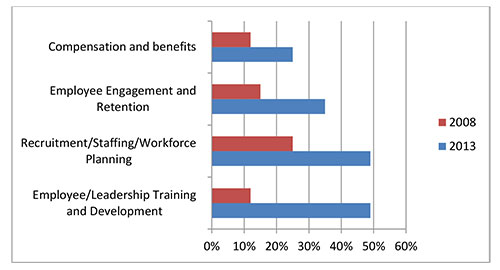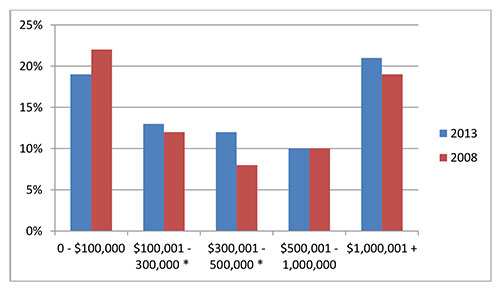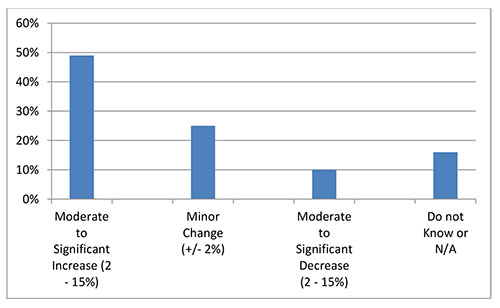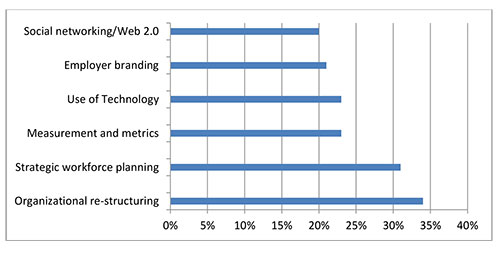HR Trends Survey 2014: Key Results
BC HRMA has been checking the pulse of the province’s HR community since 2008. Over this period, membership has provided commentary on human capital issues and trends in the province. This year more than 900 responded to the annual survey and our scope has broadened to include the Yukon. After five years of reporting on issues and trends, it is clear many of the ‘trends’ appear to be constants and the challenges that continue to face business leaders are being exacerbated by more complex working environments and ever-tightening budgets.
Chart 1 indicates that Employee/Leadership Development has firmly entrenched itself as the area requiring the most time or financial resources, while issues such as Recruitment as well as Employee Engagement are more acute than ever before.
Chart 1: Increase in Spending or Time

Chart 2: HR Budgets

Chart 2 illustrates the expenditures, including wages, of the responding HR departments. Over the 5 years of surveying, the distribution of HR spend has been relatively stable among respondents. However, respondents continue to be optimistic with regards to overall revenue projections for their respective organizations. Chart 3 indicates that nearly 50% of respondents anticipate increases to revenue of between 2 to 15%. The figures are nearly identical to the survey projections of the three previous years.
Chart 3: Projected Changes in Organizational Revenue

As organizations rebound and grow from 2008, expenditures continue to be monitored tightly and HR is playing a larger role in the direction and success of the enterprise. 59% of respondents feel that the human resources function is involved in the development of the organization’s strategy. This is a healthy increase from last year when only 33% reported being involved, which further demonstrates the growing value of the HR profession and its impact on organizations.
Members reported a number of issues that have significantly impacted HR management over the past five years. The top five cited, in order of frequency, were:
- The talent gap or skills shortage challenges, including basic language skills.
- Impact of social media and technology on both recruitment as well as productivity.
- Workforce demographics – especially noted was managing a younger workforce with less patience for organizational hierarchy, as well as dealing with the issues surrounding an aging workforce.
- Staying abreast of legislative changes, specifically harassment in the workplace and Bill 14, privacy, immigration and foreign worker recruitment.
- Increased importance of financial acumen and using metrics and analytics for HR management.
As a result of the issues raised above, survey respondents stated that they must continue their own development in the areas of strategic workforce and succession planning; creative and cost effective approaches to recruitment; and discovering ways to leverage technology for increased productivity. Building coaching capacity and leadership development programs that have a focus on conflict resolution and change management is imperative; and so to is staying abreast of employment law and using analytics for the HR function. Developing in the areas previously mentioned is reinforced when looking at the areas most often reported as being added to the responsibilities of the HR professional – Chart 4.
Chart 4: Additions to the scope of the HR department within the last year

As the environment within which organizations operate continues to change, the role of the HR professional plays a critical and multifaceted role. HR will be the translator for regulatory issues facing the organization. It will need to be the adopter of technologies necessary to remain connected to talent. HR will be a brand ambassador to model organizational culture and a strategic leader surveying for, and connecting, relevant information.
This year a total of 918 people responded to the HR Trends Survey, down from 975 in 2013. Forty-five percent of respondents indicated that they had been in HR for at least five years and 45% reported being from organizations of at least 500 or greater. There was a wide range of level of practitioner completing the survey; however, 55% of respondents indicated being at a Manager, Director, VP or SVP level.
BC HRMA will continue to use data from this survey to assist in the design of programming to better serve membership and to report on issues facing the HR community. Relevant content will be used toward research briefings and professional development, as well as initiatives such as regional government relations roundtables, where membership has an opportunity for meaningful dialogue with the politicians architecting our operating environment.
It is clear that 2014 will bring increased challenges to the human resources professionals operating in BC and the Yukon. Membership continues to manage human capital issues in an economy that is growing and facing more intense competitive pressures. Human resources professionals are challenged to keep their organizations nimble while attracting the right talent and creating the support structures to engage and develop that talent in an increasingly complex social and legislative environment.







